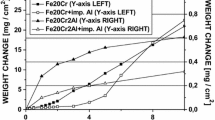Abstract
Oxygen tracer experiments were used to examine the role of oxygen movement in the development of CoO scales at 1273 K and 1373 K. Samples were oxidized in various sequences of16O2 and18O2, and the resulting isotope distributions imaged in polished sections of scales using a Camec a SIMS. Scales that were simple (i.e., plane parallel and composed of large, pore-free columnar grains) grew without a significant contribution by movement of oxygen. However, oxygen circulation within the scale was essential to the growth of duplex scales that developed after extended periods of oxidation. The relatively coarsegrained inner oxide on the purer Co grew without macroscopic separation of the scale from the metal. The oxygen for this inner scale came from the development of large pores in the columnar part of the scale. The fine-grained inner oxide on the impure Co had a crudely layered structure due to repeated sequences of scale separation followed by growth of porous oxide on the metal back to the main scale. The oxygen for these inner layers came in part from the development of large pores, but also from a more general dissociation of the base of the columnar scale. Scale failures, which occurred primarily at corners of specimens, did allow penetration of oxygen from the atmosphere to the inner scale. However, these failures sealed and were not essential for continued scale growth.
Similar content being viewed by others
References
C. Wagner,Atom Movements (ASM, Cleveland, Ohio, 1951), pp. 153–173.
A. Atkinson,Rev. Mod. Phys. 57, 437 (1985).
A. Bruckman,Corros. Sci. 7, 51 (1967).
S. Mrowec,Corrosion Sci. 7, 563 (1967).
G. Gibbs and R. Hales,Corrosion Sci. 17, 487 (1977).
S. Mrowec, T. Werber,Gas Corrosion of Metals (publication Gr NBS and NSF, Washington D.C., Foreign Scientific Publications Department of the National Centre for Scientific Technical and Economic Information, Warsaw, Poland, 1978).
F. N. Rhines, R. G. Connell, Jr., and M. S. Choi,J. Electrochem. Soc. 126, 1061 (1979).
A. Atkinson and D. W. Smart,J. Electrochem. Soc. 135, 2886 (1988).
D. P. Moon, A. W. Harris, P. R. Chalker, and S. Mountford,Mat. Sci. Tech. 4, 1101 (1988).
J. Robertson and M. I. Manning,Mat. Sci. Tech. 4, 1064 (1988).
T. A. Parthasarathy and P. G. Shewmon,Ada Metall. 32, 29 (1984).
S. Mrowec and K. Przbylski,Oxid. Met. 11, 365 (1977).
Author information
Authors and Affiliations
Rights and permissions
About this article
Cite this article
Sheasby, J.S., Gleeson, B. Oxygen tracer study of the high-temperature oxidation of pure and impure cobalt. Oxid Met 32, 379–390 (1989). https://doi.org/10.1007/BF00665445
Received:
Revised:
Issue Date:
DOI: https://doi.org/10.1007/BF00665445




